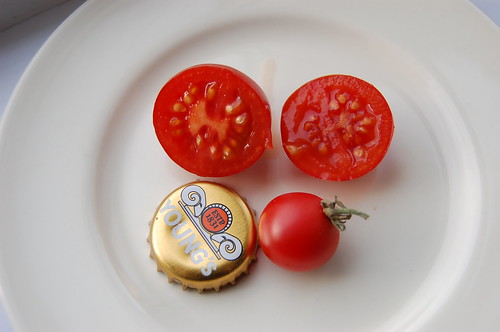
Essex Wonder
Essex Wonder - I got this one from the Heritage Seed Library, mainly for sentimental reasons. I grew up in north Essex which has (or had) an extensive market gardening and glasshouse industry. Essex Wonder was a popular market gardener's tomato from the 1930s to 1950s, extensively grown in the area before dropping from the catalogues and fading to near-extinction. I found it to be a very pleasant if rather "normal" tomato compared to the weird freakish stuff I usually grow. The fruits are almost perfectly spherical and bright red and come in a range of sizes from mini-cherry to golf ball, all with a pretty decent flavour.
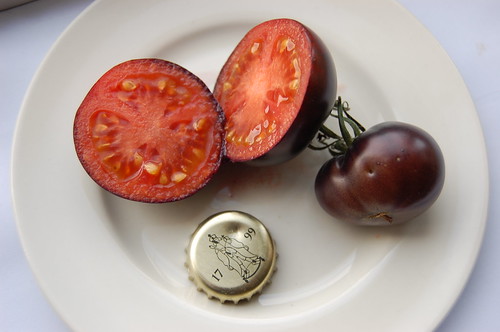
OSU Blue Fruit
OSU Blue Fruit - oh this is special! Bred by Jim Myers at Oregon State University in the US, it's a dark anthocyanin-skinned purple tomato which, given enough direct sunlight, turns coal black when it's ripe. At the moment it isn't available commercially (as far as I know); they're working on improving its flavour and shape, and this prototype is doing the rounds among curious collectors and amateur breeders. I got mine from Michael Johnson in Nottingham.
The fruits are only purple/black on the outside. Cut them open and they are red. They also stay red - or a deep bronzy red-black - on any part that doesn't get full sun, because they need strong light to develop their colour. That includes the area underneath the calyx at the top of the fruit, so they have a little red star on the top when you harvest them. They are supposedly more reliable at developing the full colour when grown outdoors, but I grew mine in the greenhouse and they came up a treat.
As with many exciting plant breeding developments, the mechanism behind the blue fruit is relatively straightforward. There are three wild species of tomato which contain some anthocyanin pigment in the fruit, each involving a different gene. Two are dominant: Abg comes from Solanum lycopersicoides while Aft is found in Solanum chilense, and the recessive atv comes from Solanum cheesemanii. All of these genes have already been bred into cultivated tomatoes over the years, without producing fully blue fruits. What the OSU team discovered was that if you combine all three of these genes together you get a cumulative effect which intensifies the pigment. Voilà blue fruit.
The downside of OSU Blue Fruit is said to be its flavour, which has a reputation for being "inky". Anthocyanins are normally tasteless, but they're often accompanied by other compounds and biochemical changes which can affect the flavour. Consequently I wasn't expecting that much from it in the way of taste. But I was pleasantly surprised - it was actually pretty palatable. I'd be lying if I said it was up there with the best tasting tomatoes, but it certainly wasn't poor either … it was as good as or better than most of what you'd find in the supermarket.
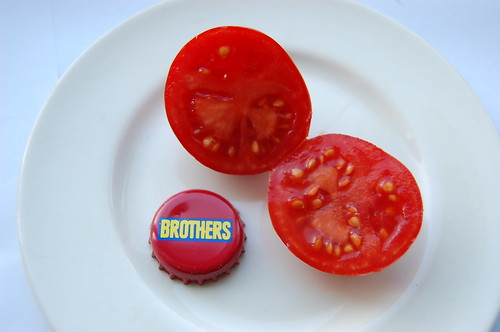
Pugliese Green
Pugliese Green - this Italian variety was given to me by Jeremy Cherfas over at Agricultural Biodiversity. Despite the name, it's very much a red tomato, and doesn't look significantly different from other red tomatoes, though it has a certain intensity of colour. There is one thing that makes it stand out though - the flavour is stupendously good. I'm even able to nibble at it raw (see below). It's fruity and juicy and succulent with just the right balance of gel and flesh, and will probably become a flavour benchmark for me. Thank you Jeremy.
That was last year's crop. Meanwhile the 2010 crop is going nuts in the greenhouse making the most of the unlikely sunny weather. Here's what I've got crammed in there …
OSU Blue Fruit
Tangella
Isis Candy
Anna Russian
Green Zebra
Green Tiger
Darby Striped Pink/Yellow
Darby Striped Red/Green
Pugliese Green
Essex Wonder
Pink Freud F3 (one of my own experiments)
Banana Legs x Green Tiger F1 (another bit of hand-pollinated jiggery pokery)
The horrendous affliction of late blight means that it's no longer practical to grow tomatoes anywhere but inside the greenhouse, where they're sheltered from the warm summer rain which brings the deadly spores to the garden. Normally it's not worth trying to grow any outdoor tomatoes any more, but Patrick kindly sent me some seeds of Tomatito de Jalapa, which is supposed to be blight resistant. There are genes for blight resistence in certain wild species of tomato, and some of these are being bred into garden varieties. From what I gather, this has been working OK with small cherry tomatoes but is not much cop when it comes to the big-fruited types. So if you want blight resistance you have to have tiddly little fruits. Which is fine by me, I don't mind. I have little knowledge of what Tomatito de Jalapa is like or how assiduously it fends off blight, but I'm looking forward to experimenting with it. The greenhouse is full, but the beauty of this one is that I can grow it outdoors.
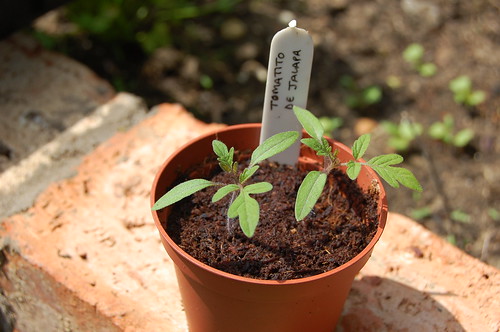
Tomatito de Jalapa seedlings, as photographed a couple of weeks ago. They have since been potted up individually and are growing like rockets.
I've also got another tomato that I pinched from a restaurant. I don't know what variety it is, but I had to have it. At this point I need to confess something. I actually hate raw tomatoes, and can't eat them unless they're mixed with something else. I love them cooked, and I love growing them, but when it comes to snacking them off the vine - forget it. They actually make me gag. But a couple of months ago I was in a little basement restaurant in Cheltenham called Café Rubik, which does very nice food. The curse of being vegetarian though is that everything you order always comes with salad. Chefs seem to assume that all vegetarians are health freaks and don't want to eat chips or anything stodgy and interesting, so if you're vegetarian simply because you don't want to eat dead animals but do want to eat stodgy interesting and unhealthy stuff without dead animals in, you're out of luck. So, confronted with the mandatory pile of bleak greenery, I was thinking "fuck, how am I going to get through all these raw tomatoes?" But when I nibbled the edge of one I was surprised to find it rather fruity. I nibbled a bit more. It didn't taste of tomatoes at all, it was like a tangy little fruit - a cape gooseberry or something. I then astounded myself by eating a whole one, and actually enjoyed it. This really was a momentous event because I've never eaten a raw tomato like that before. It was unprecedented.
Well obviously there's only one thing you can do in those circumstances, and that's steal one to take home and get the seeds out of it. I waited some while for a moment when the waiter wasn't looking, but he seemed to be looking all the time, so in the end I just grabbed one and shoved it in my pocket. He looked a bit surprised but didn't say anything. I took it home and fermented the gel and got quite a few seeds from it. Although received wisdom has it that tomatoes need to over-ripen to the point of inedibility in order to produce mature seed, I've always had perfectly good results saving seeds from eating-stage tomatoes, and indeed other vegetables. If you like the taste of it scrape some seeds out of it, that's my motto.
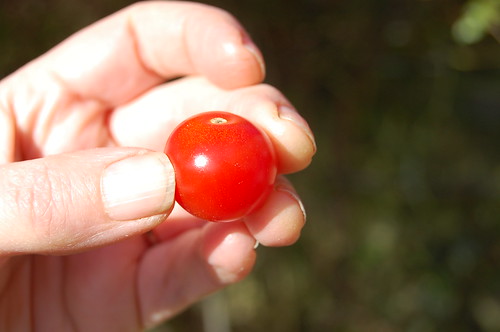
The original Café Rubik tomato, as pilfered.
Sure enough the seeds germinated rampantly and have grown into very healthy plants. They all look the same so far too, which is a good sign, as it implies that it's a true-breeding open pollinated variety and not a hybrid. I've no idea what variety it is, though presumably it does have a real name. It might even be a well known mainstream commercial variety for all I know. But I've called it Café Rubik in lieu of an identification. Not much to tell from its outer appearance … it's round, and red, and tomatoish. I'll post pictures of the plants as they grow in case anybody recognises it.
17 comments:
Please could you explain fermented the gel to a complete novice seed-saver?
Many thanks :}
Yes of course. The "proper" way to save tomato seeds is to slop out the seeds complete with their gel into a small container, with a tiny drop of water if necessary, and leave it to ferment for a few days. It's actually rather disgusting and goes mouldy on the top, but this process break down the germination inhibitors around the seeds and leaves them nice and clean and fluffy, and (allegedly) free of seed-borne diseases. After fermenting, you just rinse the seeds in a tea-strainer and leave them to dry. I wrote a more detailed post about it here: http://daughterofthesoil.blogspot.com/2008/09/saving-seed-from-tomatoes.html
Thanks Rebsie, really appreciate the info. I'd never have known to do this and would have assumed the mouldy bit meant they'd "gone off" and needed to be thrown away.
Me thinks a comfy evening reading all your archives is in my future!
I scrape them straight from the eating fruit too Rebsie. At that stage you know you like it. I don't have any germination problems with them either.
It wasn't pilfered - you'd paid for the thing. For excellent tomatoes eaten out, we should all have a 'doggy pocket'!
Be sure not to give the Tomatito de Jalapa ANY fertiliser. Frank and some others have been experimenting with this, and even just a small amount of organic fertilizer causes the plant to be much more susceptible to blight. I had pretty good luck with companion planting beans, if you think the plant needs some help.
Also Tom discussed the idea of fermenting tomato and potato seeds in Oxford last year, and his opinion is it's better not to. He finds it best to remove the gel coating with TSP (can you buy this in the UK?), which is a strong household cleaner. I've heard people elsewhere on the Internet suggest using the white powder you use to clean toilets (is this called vim or ajax in the UK?). Tom is not shy about admitting his seeds are not organic.
It's funny the wide range of opinions that exist on this...
Thanks for that tip Patrick. I'm a very low user of fertiliser, but it's useful to know. Interestingly I had some tomatoes last year which suffered extreme neglect - no fertiliser or water at all for months - and although they were smaller than one would normally expect, they were FAR healthier - and no blight. So I'm going to experiment with cutting down on the mollycoddling this year on all my tomatoes, just to see.
The issues around tomato/potato seed saving are full of conflicting views, but here's mine. I understand why Tom wants all his seeds to be immaculately disease-free - he needs to be above criticism from the commercial potato industry, and wants to maintain a high standard, which I completely respect. The trisodium phosphate he uses isn't readily available in the UK, and even if it was, I don't think I'd want to use it. Simply because using harmful chemicals on seeds and gardens feels completely counterintuitive to my earthy hippy pagan soul ... and if that means I have to live with a few more pests and diseases, so be it. I know not everyone sees it that way but it's a personal choice. (My understanding is that TSP is not toxic as such, but causes substantial environmental damage when it gets into watercourses.) So far I've not had any problems using the fermentation method, or the even worse scoop-'em-out-on-a-bit-of-kitchenroll method. I've saved potato seeds just by slopping them out into a bowl of water and not fermenting them at all, and had no disease or germination problems. Maybe I've just been lucky - but I've spent a lifetime not doing things the right way and getting away with it. There are plenty enough bugs and nasties in the soil, so it seems a bit futile to get too precious about the cleanliness of seeds. I know Tom wouldn't agree with me, but I'm happy to take my chances for the sake of an organic garden and an easy life.
TSP has phosphate in it, in a similar way to chemical fertilizer. When it gets into natural water sources, it strongly promotes the growth of algae. I think it can also cause sudsing.
I think even now European laundry soap contains a little bit of it. It's very effective as a cleaning agent, even in small amounts.
In the city of Chicago it's illegal, because they have problems there with sudsing and algae. The stores sell specially formulated laundry soap.
No, it's not good for the environment, and better not to use, but if it's only in small amounts there are probably worse things...
I'm with you, I would rather just ferment my seeds. It certainly doesn't belong in an organic garden.
I agree Patrick. Yes there are worse things, and small scale use for seed cleaning wouldn't do significant harm. I just prefer to avoid it until I'm convinced there's a good case for using it. Fermenting seems to work perfectly well.
I buy ecological laundry soap too, so no phosphates down my drains!
I don't want to rain on your tomato parade, but I found that Tomatito de Jalapa was not very blight resistant last year. This could be connected with the fact that I had to prune it back from the path and the ensuing damage allowed the blight spores to get established. Our soil must be thoroughly infested with oospores by now.....I suspect that with the amount of genetic shuffling blight is now able to do, blight resistant is a relative, rather than absolute term.
But we're going to have a hot, dry summer this year - aren't we?
Good luck and sounds like you know quite a lot about anthocyanins already.
I think Patrick is on the money with fertiliser and disease. I read somewhere that Alan Kapuler no longer fertilises his tomatoes and gets better disease resistance. It gels with other things I've read/learned. It raises the question of just how one maintains healthy, nutrient dense soils so that we can grow healthy, nutrient dense food. I wish someone would come up with a prescription - do x, y, and z and hey presto, healthy soil and no disease. I suspect though that that that's one box I'll never be able to tick!
No worries Owen, I wasn't expecting miracles. I've nothing to lose by trying it, and really a lot is down to the luck of the weather. I've had so much blight in the garden over the last few years it must be oospore heaven here by now.
I had to look up the stuff about anthocyanin genes! But I'm learning all the time.
Raymondo - it's all very interesting. I've almost stopped using fertiliser in the garden because I found it simply didn't need it ... and I'm beginning to wonder if, as you say, it does more harm than good. It ties in with the most fundamental of organic principles, that if you look after the soil the plants will take care of themselves. Easier said than done I know, but I'm finding that a bit of leaf mould or compost dug into the soil is more effective than any fertiliser product.
Hi Rebsie, I've been reading your blog for a while and finding it very informative and useful, especially the information / rant about F1 hybrids and your fascinating pea-breeding project. :-)
Last year was my first tomato seed-saving experiment. I squeezed out the seeds, dried them in the sun and rubbed off the gel. I got good germination this spring, although some were slow to germinate and some failed to grow properly. Win some, lose some, I guess!
I've given up hoping for blight resistance, and have taken to making shelters from polythene to grow tomato plants under. Blight won't spread if plants aren't wet for hours. Keeping the plants dry is key to avoiding massive losses.
Last year I had some blight on my tomato plants, but it spread slowly and they survived until early December, as November was frost-free.
Wishing you an excellent crop.
PS - nice beer tops too. Wouldn't mind trying them out!
kevs - nice to hear from you. You're right about keeping the rain off the tomatoes. If I was better at constructing things like that I would try out the shelter idea.
Kath - indeed I do like a nice real ale! Lovely to glug in the garden when I'm working on a warm day.
I've been growing and distributing this tomatito de jalapa for quite a bit of years now, and it's fairly resistant, the best I've tried yet, better than most of the wild tomatoes: humboldtii, columbianum, hirsutum (which gave me no fruit at all), pavabaccatum,..
Only once did I see it sick, yes, late blight, in a very fertile soil and a bit overshaded by some trees. What was really strange was the way it grew over there, very very long stems with few leaves and few tomatoes (probably due to this fertile soil), over here it's quite bushy and loaded with leaves and fruits. As a ground cover I try to use as much equisetum as possible, ordinary grass cuttings that are used as a ground cover can be a host for blight spores, and equisetum has mild anti-fungi characteristics.
Owen, sorry to hear that, I prune mine quite often (in sunny weather though) because they become just way too big, and I never get any late blight until autumn really settles in (second half of O ctober probably...)
Rebsie, keep up the wonderful job over here!!!
Frank
Nice information is shared in this article. The content is so pleasing to the eyes. Keep share more blogs with us. Positive response must be given. Awesome work. Now it's time to avail https://sallimos.com/ for more information.
The OSU Blue tomato is unique primarily due to its deep blue to black coloration, which comes from high levels of anthocyanins—powerful antioxidants also found in blueberries.
Post a Comment